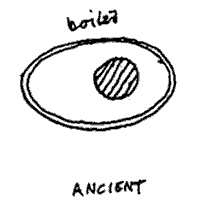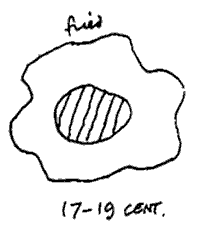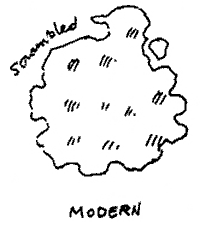 |
3. Models of Urban Development
The onset of industrialization radically changed the makeup of cities. Formerly compact cities spread into open space, so that today the suburbanization of living and working comprises the greater part of modern city development. The motorization of society together with growing individual income brought about the first highpoints of this development in the 1960's in Germany, comparable to the development in the U.S. 40 years earlier. A standstill has not been reached, rather cities continue to spread. [Ronneberger/Lanz/Jahn 1999] The English architectural critic, Cedric Price [1991] visualized the different historical stadiums of city development in a very understandable manner by comparing them with different methods of preparing an egg. Price argued that the cities of antiquity through history all the way to the cities of the absolutist late-baroque period with a center and an outer area within fortifying walls are comparable to a hard-boiled egg with yolk and shell. The city spreads outward during industrialization. Suburban space and a freely flowing fringe surround a loosely knit core. The industrial metropolis takes on the form of a fried egg. Today's city is similar to a scrambled egg with bits of bacon. Center and periphery are mixed and splay out to all sides - the urban sprawl. An important key to the understanding of urban sprawl is mobility - understood as the freedom of movement on the one hand and actually carried-out movement on the other. Mobility is defined by four factors: activity, route traveled, duration and distance. The amount of time spent per day on the move (one hour) as well as the number of routes traveled and activities carried out has remained constant over the past 30-40 years. The only variable which has changed is that of distance. Due to the fact that the automobile became accessible for broad segments of the population and thus turned into the mass transportation vehicle of choice the variable of distance has doubled if not tripled. This formed the basis for the shift of urban activities to the surrounding area. [Topp 1994] The relationship towards mobility, especially the choice of transportation is considered to be a dominant factor in the development of urban sprawl.
|
||||
 |
|||||
 |